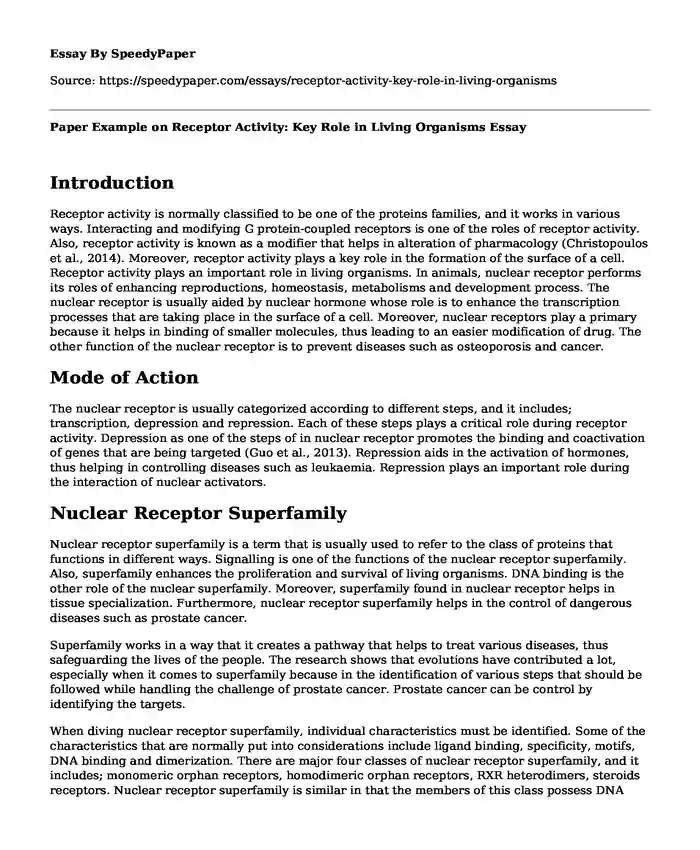Introduction
Receptor activity is normally classified to be one of the proteins families, and it works in various ways. Interacting and modifying G protein-coupled receptors is one of the roles of receptor activity. Also, receptor activity is known as a modifier that helps in alteration of pharmacology (Christopoulos et al., 2014). Moreover, receptor activity plays a key role in the formation of the surface of a cell. Receptor activity plays an important role in living organisms. In animals, nuclear receptor performs its roles of enhancing reproductions, homeostasis, metabolisms and development process. The nuclear receptor is usually aided by nuclear hormone whose role is to enhance the transcription processes that are taking place in the surface of a cell. Moreover, nuclear receptors play a primary because it helps in binding of smaller molecules, thus leading to an easier modification of drug. The other function of the nuclear receptor is to prevent diseases such as osteoporosis and cancer.
Mode of Action
The nuclear receptor is usually categorized according to different steps, and it includes; transcription, depression and repression. Each of these steps plays a critical role during receptor activity. Depression as one of the steps of in nuclear receptor promotes the binding and coactivation of genes that are being targeted (Guo et al., 2013). Repression aids in the activation of hormones, thus helping in controlling diseases such as leukaemia. Repression plays an important role during the interaction of nuclear activators.Nuclear Receptor Superfamily
Nuclear receptor superfamily is a term that is usually used to refer to the class of proteins that functions in different ways. Signalling is one of the functions of the nuclear receptor superfamily. Also, superfamily enhances the proliferation and survival of living organisms. DNA binding is the other role of the nuclear superfamily. Moreover, superfamily found in nuclear receptor helps in tissue specialization. Furthermore, nuclear receptor superfamily helps in the control of dangerous diseases such as prostate cancer.
Superfamily works in a way that it creates a pathway that helps to treat various diseases, thus safeguarding the lives of the people. The research shows that evolutions have contributed a lot, especially when it comes to superfamily because in the identification of various steps that should be followed while handling the challenge of prostate cancer. Prostate cancer can be control by identifying the targets.
When diving nuclear receptor superfamily, individual characteristics must be identified. Some of the characteristics that are normally put into considerations include ligand binding, specificity, motifs, DNA binding and dimerization. There are major four classes of nuclear receptor superfamily, and it includes; monomeric orphan receptors, homodimeric orphan receptors, RXR heterodimers, steroids receptors. Nuclear receptor superfamily is similar in that the members of this class possess DNA binding domain, N-terminal domain and a hinge region. Ligand binding domain and DNA binding domain are some of the common nuclear receptors that are normally conserved (Corrigan et al., 2013). Ligand binding performs its functions in a way that it is involved in the specialization process. Also, ligand binding initiates activation process. Moreover, ligands are usually classified differently as a way of separating one class from the other, for instance, differentiating ligands for metabolites from that of hormones. The other way in which ligands can be differentiated from other members is through the use of dimerization. Homodimerization also helps to strengthen the DNA through the process of binding with the aid of the zinc finger. Sequencing and structural analysis should also be put into consideration.
References
Christopoulos, A., Changeux, J. P., Catterall, W. A., Fabbro, D., Burris, T. P., Cidlowski, J. A., ... & Sexton, P. M. (2014). International Union of Basic and Clinical Pharmacology. XC. Multisite pharmacology: recommendations for the nomenclature of receptor allosterism and allosteric ligands. Pharmacological Reviews, 66(4), 918-947.
Corrigan, R. M., Campeotto, I., Jeganathan, T., Roelofs, K. G., Lee, V. T., & Gründling, A. (2013). Systematic identification of conserved bacterial c-di-AMP receptor proteins. Proceedings of the National Academy of Sciences, 110(22), 9084-9089.
Guo, Y., Wang, W., Wang, J., Feng, J., Wang, Q., Jin, J., ... & Shen, B. (2013). Receptor for activated C kinase 1 promotes hepatocellular carcinoma growth by enhancing mitogenactivated protein kinase kinase 7 activity. Hepatology, 57(1), 140-151.
Cite this page
Paper Example on Receptor Activity: Key Role in Living Organisms. (2023, Nov 30). Retrieved from https://speedypaper.net/essays/receptor-activity-key-role-in-living-organisms
Request Removal
If you are the original author of this essay and no longer wish to have it published on the SpeedyPaper website, please click below to request its removal:
- Free Essay for You: Philosophy of Language, Frege and Russel
- Free Essay Comparing Jokes: Freud and Douglas' Perspectives
- Essay Sample with the Discussion about Native American
- Free Essay Example - Perineal Prostatectomy
- Paper Example. Description of The Pathology
- Essay Sample on Data Collection Methods That Were Not Used for Each of the Studies
- Advantages of Building Space for the Orthopedic Line. Essay Example
Popular categories





